当前位置:网站首页>Concepts and theories related to distributed transactions
Concepts and theories related to distributed transactions
2022-07-04 12:45:00 【Melting pole】
1 Basic concepts
1.1 What is business
What is business ? Let me give you an example from life : You go to the grocery store to buy ,“ Hand in hand , Delivery on one hand ” It's an example of a transaction , Payment and delivery must all be successful , Business is a success , Any activity fails , Transaction will undo all successful activities .
Understand examples , Let's look at the definition of business :
Business can be seen as a big activity , It has different small activities , These activities are either all successful , All or nothing .
1.2 Local transactions
In computer system , It's more about controlling transactions through relational databases , This is achieved by using the characteristics of the database itself , So it's called database transaction , Because applications mainly rely on relational databases to control transactions , The database is usually on the same server as the application , Therefore, transactions based on relational databases are also called local transactions .
Review the four features of database transactions :ACID.
A(Atomic): Atomicity
All operations that make up a transaction , Or it's all done , Or none at all , Partial success and partial failure are not possible .
C(Consistency): Uniformity
Before and after transaction execution , The consistency constraint of the database is not broken . such as : Zhang San turns to Li Si 100 element , The data before and after the transfer is in the correct state, which is called consistency , If Zhang San turns out 100 element , Li Si's account number has not been increased 100 This leads to a data error , There is no consistency .
I(Isolation): Isolation,
Transactions in a database are usually concurrent , Isolation means that the execution of two concurrent transactions does not interfere with each other , One transaction cannot see the intermediate state of other transaction running processes . Dirty reads can be avoided by configuring the transaction isolation level 、 Repeat reading and so on .
D(Durability): persistence
After the transaction completes , Changes to data from this transaction are persisted to the database , And will not be rolled back .
When database transaction is implemented, all operations involved in a transaction will be incorporated into an indivisible execution unit , All operations in the execution unit are either successful , Or they all failed , As long as any of these operations fail , Will cause the entire transaction to roll back .
Distributed transactions
With the rapid development of Internet , Software system from the original single application to distributed application , The following figure describes the evolution of monomer applications to microservices :
The distributed system will split an application system into multiple services that can be deployed independently , Therefore, remote cooperation between services is needed to complete transaction operations , In this kind of distributed system environment, different services cooperate with each other remotely through the network to complete the transaction, which is called distributed transaction , For example, users register to send points transaction 、 Create order inventory reduction transaction , Bank transfer transactions are distributed transactions .
We know that local transactions rely on the transaction features provided by the database itself to implement , So the following logic can control local transactions :
begin transaction;
//1. Local database operations : Zhang San reduces the amount
//2. Local database operations : Li Si increases the amount
commit transaction;
But in a distributed environment , It's going to be like this :
begin transaction;
// 1. Local database operations : Zhang San reduces the amount
// 2. The remote invocation : Let Li Si increase the amount
commit transaction;
You can imagine , When the remote call made Li Si increase the amount, it succeeded , The remote call did not return... Due to network problems , At this time, if the local transaction fails to commit, Zhang San's operation of reducing the amount is rolled back , At this time, the data of Zhang San and Li Si are inconsistent .
So on the basis of distributed architecture , Traditional database transactions cannot be used , The accounts of Zhang San and Li Si are not in the same database or even in the same application system , To implement the transfer transaction, you need to call , Due to network problems, it is good to cause distributed transaction problems .
1.4 Distributed transaction generation scenario
1、 The typical scenario is microservice architecture , The microservices complete the transaction operation through remote call . such as : Order and inventory microservices , While placing an order, the order micro service requests the inventory micro service to reduce inventory . In short : Span JVM Process generates distributed transaction .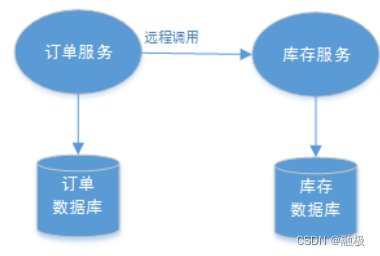
2、 A single system accesses multiple database instances , When a single system needs to access multiple databases ( example ) Distributed transactions are generated . such as : User information and order information are respectively in two MySQL Instance store , User management system delete user information , You need to delete user information and user order information respectively , Because the data is distributed in different data instances , Need to operate data through different database links , A distributed transaction is generated . in short : Generate distributed transactions across database instances .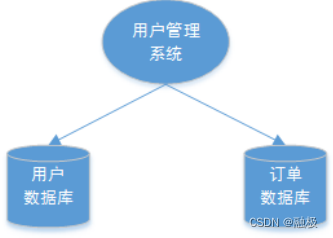
3、 Example of multiple services accessing the same database , such as : Order and inventory microservices generate distributed transactions even if they access the same database , The reason is cross JVM process , The two micro services hold different Database link for database operation , A distributed transaction is generated .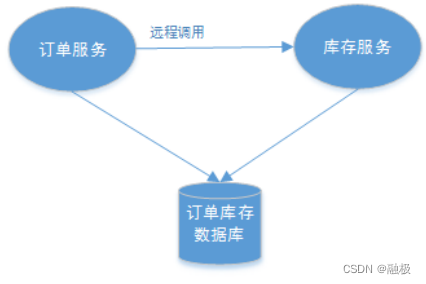
All in all , A distributed transaction can be split into multiple local transactions , No matter whether the local transaction operates a database instance , Only different local transactions form a large logical transaction , This logical transaction is a distributed transaction .
2 Basic theory of distributed transaction
Through the previous study , We understand the basic concepts of distributed transactions . Unlike local transactions , Distributed system is called distributed system , It's because the nodes that provide services are distributed on different machines , Interact with each other through the Internet . The whole system can't provide services because of a little network problem , The network factor has become one of the criteria for distributed transactions . therefore , Distributed transactions need further theoretical support , Next , Let's first learn about distributed transactions CAP theory .
Before explaining the distributed transaction control solution, you need to learn some basic theories , Through theoretical knowledge, we can determine the goal of distributed transaction control , To help us understand each solution .
2.1 CAP theory
2.1.1 understand CAP
CAP yes Consistency、Availability、Partition tolerance An abbreviation for three words , They mean consistency 、 Usability 、 Zone tolerance .
Let's explain separately :
For the convenience of CAP Theoretical understanding , We understand the business scenarios in e-commerce system CAP.
Here's the picture , Is the implementation process of commodity information management .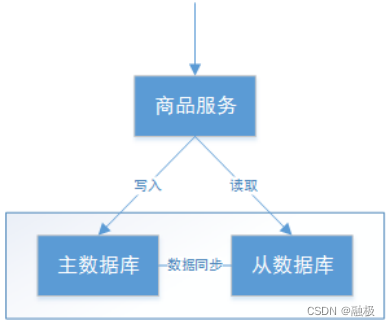
The overall implementation process is as follows :
- Commodity service requests the master database to write commodity information ( Add the goods 、 Modify the goods 、 Delete item ).
- The main database successfully writes the response of goods and services .
- Commodity service requests to read commodity information from the database .
C-Consitency
Consistency means that the read operation after the write operation can read the latest data status , When The database is distributed on multiple nodes , The data read from any node is the latest state .
Above picture , To achieve consistency in reading and writing commodity information is to achieve the following goals :
- Goods and services are successfully written into the master database , Then query the new data from the database successfully .
- Commodity service failed to write to master database , It also fails to query the new data from the database .
How to achieve consistency ? - Write into the master database to synchronize the data to the slave database .
- After writing into the main database , Lock the slave database during synchronization to the slave database , Release the lock after synchronization . So as not to write the new database successfully , Query old data from database .
Characteristics of distributed system consistency
- Because of the process of data synchronization , There will be a certain delay in the response of the write operation .
- In order to ensure data consistency, resources will be temporarily locked , Wait for data synchronization to finish releasing locked resources .
- An error message is returned if the node that failed to request data synchronization , Never return old data .
A-Availability
Availability means that any transaction operation can get response results , And there will be no response timeout or response error .
Above picture , Product information reading to meet the availability is to achieve the following goals :
- Data query requests received from the database can immediately respond to the data query results .
- Response timeout or response error is not allowed from database .
How to achieve usability - Write into the master database to synchronize the data to the slave database .
- Because to ensure the availability of the slave database , You cannot lock resources from the database .
- Even if the data hasn't been synced , Return the data to be queried from the database , Even old data , If you don't have any old data, you can return a default message by convention , But can't return an error or response timeout .
Features of distributed system availability - All requests are answered , And there will be no response timeout or response error .
P-Partition tolerance
Usually each node of the distributed system is deployed in different subnets , This is the Internet Partition , Inevitably, the communication between nodes will fail due to network problems , At this time, we can still provide external services , It's called zone tolerance .
Above picture , Reading and writing commodity information to meet the tolerance of zoning is to achieve the following goals :
- Failure to synchronize data from master data to slave database does not affect read and write operations .
- If one node is hung up, it will not affect the service provided by the other node .
How to achieve partition tolerance - Try to use asynchronous instead of synchronous operation , For example, use asynchronous method to synchronize data from database to slave database , In this way, loose coupling between nodes can be realized effectively .
- Add from database node , One of the nodes hangs up and the other slave nodes provide services .
Characteristics of distributed partition tolerance - Partition tolerance is the basic ability of distributed system .
CAP combination
- Whether there are examples of commodity management at work CAP Well ?
In the scenario of indexed distributed transactions, there will not be CAP Three characteristics , Because I have P Under the premise of C and A Can't coexist .
For example, the following figure satisfies P That means partition tolerance is achieved :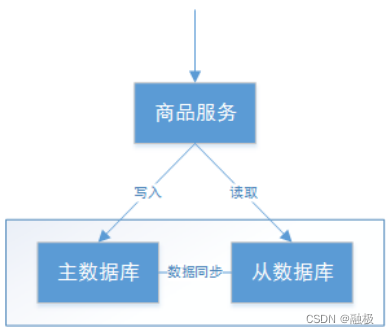
The meaning of partition tolerance in this figure is : - The master database synchronizes data to the slave database through the network , It can be considered that the primary database is deployed in different partitions , Interact through the network .
- When there is a problem in the network between the master database and the slave database, it will not affect the service provided by the master database and the slave database .
- When one node is down, it does not affect the other node to provide services .
If we want to achieve C Data consistency must be ensured , In order to prevent inconsistent data from being queried from the slave database during database synchronization, the slave database needs to be locked , Unlock after synchronization , If the synchronization fails, an error message or timeout message should be returned from the database .
If we want to achieve A Data availability must be guaranteed , You can query data from the database at any time , Will not respond to timeout or return error messages .
Through the analysis, we found that in the satisfaction of P Under the premise of C and A There are contradictions .
CAP What are the combinations
Therefore, in the production of distributed processing, we should determine the satisfaction according to the needs CAP Those two aspects of .
- AP
Give up consistency , The pursuit of partition tolerance and usability , This is the choice of many distributed system designs .
for example :
Commodity management above , It can be realized AP, The premise is that as long as the user can accept that the queried data is not the latest within a certain period of time .
Usually achieve AP Will guarantee final consistency , The following will be BASE Theory is the basis AP To expand , Some business scenarios , such as : Order refund , Today's refund is successful , Tomorrow account arrival , As long as the user can accept the payment within a certain period of time . - CP
Discard availability , Pursue consistency and partition fault tolerance , our zookeeper In fact, the pursuit of strong consistency , Another example is inter-bank transfer , An inter-bank transfer request is not completed until the entire transaction is completed by both banking systems . - CA
Give up partition fault tolerance , That is to say, there is no partition , Do not consider the problem of network impassability or node hang up , You can achieve consistency and availability . Then the system will not be a standard distributed information , Our most commonly used relational databases meet CA.
Commodity management above , If we want to achieve CA The structure is as follows :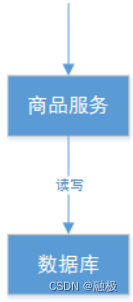
There is no data synchronization between master database and slave data , The database can respond to every query request , Each query request can return the latest data through the transaction isolation level .
summary
Through the above we have learned CAP Knowledge of theory ,CAP It's a proven theory : A distributed system can only satisfy the consistency at most 、 Availability and partition tolerance are two of the three . It can be used as our architecture design 、 Consideration criteria for technology selection . For most large Internet application scenarios , There are many nodes 、 Deployment is decentralized , And now the scale of the cluster is growing , So node failure 、 Network failure is the norm , And make sure the service availability reaches N individual 9(99.999…%), And to achieve good response performance to improve the user experience , Therefore, the following choices are generally made : Guarantee P and A, Abandon C Strong consistency , Ensure ultimate consistency .
BASE theory
Understand strong consistency and final consistency
CAP Theory tells us that a distributed system can only meet consistency at most 、 Availability and partition tolerance are two of the three , among AP More in practical application ,AP Abandon consistency , Ensure availability and partition tolerance , But in actual production, many scenarios need to achieve consistency , For example, in the previous example, the master data synchronizes data from the slave database , Even if there is no consistency , But in the end, we also need to synchronize data successfully to ensure data consistency , This consistency and CAP The consistency is different ,CAP The consistency of requires that the data of each node must be consistent at any time , It emphasizes strong consistency , But the ultimate consistency is to allow the data of each node to be inconsistent over a period of time , But after a period of time, the data of each node must be consistent , It emphasizes the consistency of the final data .
Base The theory is introduced
BASE yes Basically Availiable( Basically )、Soft state( Soft state ) and Eventually consistent( Final consistency ) Abbreviations of three short messages .BASE The theory is right CAP An extension of , Availability achieved by sacrificing strong consistency , In case of failure, it is allowed that some parts are not available but the core functions shall be available , Allow data to be inconsistent over time , But in the end it's consistent . Satisfy BASE Theoretical business , We call it “ Flexible business ”.
- Basic available : When the distributed system fails , Allow the loss of some available functions , Make sure the core functions are available . Such as , There is something wrong with the payment of e-commerce website transactions , Products can still be viewed normally .
- Soft state : Because don't ask for strong consistency , therefore BASE Allow intermediate states in the system ( It's also called soft state ), This state does not affect system availability , As of the order “ In the payment ”、“ Data synchronization ” Equal state , After the data is finally consistent, the status changes to “ success ” state .
- Final agreement : Final agreement means after a period of time , All node data will be consistent . As of the order “ In the payment ” state , In the end, it will become “ Successful payment ” perhaps “ Failure to pay ”, Agree the order status with the actual transaction result , But it takes a certain delay 、 wait for .
3 Distributed transaction solution 2PC( Two-phase commit )
I've learned the basic theory of distributed transaction , Based on Theory , Common solutions for different distributed scenarios in the industry are 2PC、TCC、 The final consistency of reliable information 、 Try your best to inform several .
3.1 What is? 2PC
2PC I.e. two phase submission agreement , The whole transaction process is divided into two stages , Preparation stage (Prepare phase)、 Submission phase (Commit phase),2 It means two stages ,P It means the preparation stage ,C It's the submission phase .
give an example : Zhang San and Li Si haven't seen each other for a long time , Old friends have a dinner party , The boss of the restaurant asked to pay first , To issue tickets . At this time, Zhang San and Li Si respectively complained about the current situation , There's shyness in the bag , Don't want to treat , Then only AA. Only Zhang San and Li Si paid , Only the boss can arrange the meal . But because Zhang San and Li Si are iron roosters , It was an embarrassing scene :
- Preparation stage : The boss asked Zhang San to pay , Zhang San pays . The boss asked Li Si to pay , Li Si paid .
- Submission phase : The boss issues tickets , The two of them took their seats for dinner .
A transaction is formed in the example , If one of Zhang San or Li Si refuses to pay , Or there is not enough money , The shop owner will not issue tickets , And will return the collected money to .
The whole transaction process is composed of transaction manager and participants , The shopkeeper is the thing manager , Zhang San 、 Li Si is the participant of things , The transaction manager is responsible for deciding whether to commit or rollback the entire distributed transaction , Transaction participants are responsible for committing and rolling back their local transactions .
In the computer, some relational databases such as Oracle、MySQL Support for two-phase commit protocol .
- Preparation stage (Prepare phase): The transaction manager sends... To each participant Prepare news , Each database participant performs transactions locally , And write the local Undo/Redo journal , The transaction is not committed at this time .
(Undo Log is to record the data before modification , For database rollback ,Redo Log is to record the modified data , Used to write data files after committing transactions ). - Submission phase (Commit phase): If the transaction manager receives an execution failure or timeout message from the participant , Send a rollback directly to each participant (Rollback) news ; otherwise , Send submit (Commit) news ; The participant performs commit or rollback operations according to the instructions of the transaction manager , And release the lock resources used in transaction processing . Be careful : Resources must be released in the final stage .
The following figure shows 2PC Two stages of , It is divided into success and failure :
Successful cases :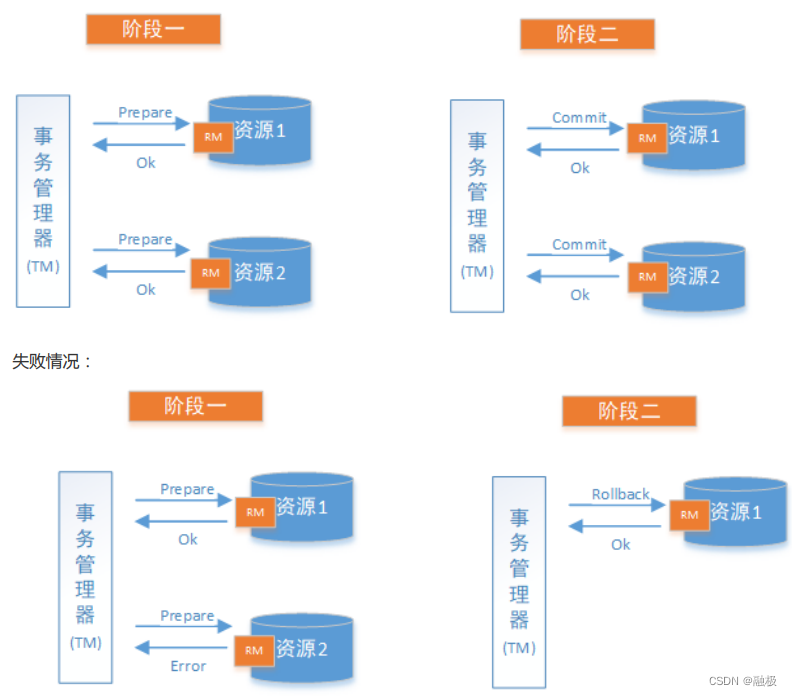
3.2 Solution
3.2.1 XA programme
2PC The traditional solution is implemented at the database level , Such as Oracle、MySQL All support 2PC agreement , In order to unify standards and reduce unnecessary docking costs in the industry , Standard processing models and interface standards need to be formulated , International Open Standards Organization Open Group The distributed transaction processing model is defined DTP(Distributed Transaction Processing Reference Mode).
In order to make it clear XA The content of the plan , The following new user registration send points as an example to illustrate :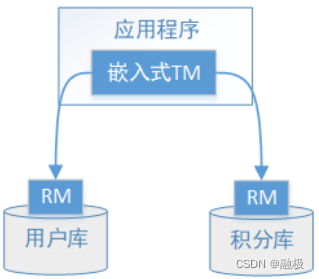
The execution process is as follows :
- Applications (AP) Hold two data sources: user database and credit database .
- AP adopt TM Notify the user base RM New users , At the same time, inform the point bank RM Add points for this user ,RM The transaction is not committed at this time , At this time, users and integration resources are locked .
- TM Received execution reply , As long as one side fails, think of the others RM Initiate a rollback transaction , Rollback complete , Resource lock release .
- TM Received execution reply , All success , At this point, index RM Initiate commit transaction , Submitted , Resource lock release .
DTP The model defines the following roles :
- AP(Application Program): Applications , Can be understood as using DTP The program of distributed transaction .
- RM(Resource Manager): Resource manager , It can be understood as a participant in a transaction , In general, it refers to a database instance , Control the database through resource manager , The resource manager controls this branch transaction .
- TM(Transaction Manager): Transaction manager , Responsible for coordination and management of affairs , The transaction manager controls the global transaction , Manage the life cycle of a transaction , And coordinate the various RM. Global transaction refers to the distributed transaction processing environment , You need to operate multiple databases to complete a work, which is a global transaction .
- DTP Model definition TM and RM The interface specification for communication between is XA, Simple understanding of the 2PC agreement , database-based XA Protocol to implement 2PC Also known as XA programme .
- The interaction between the above three roles is as follows :
- TM towards AP Provide application programming interface ,AP adopt TM Commit and roll back transactions .
- TM adopt XA Interface to inform RM Start of database transaction 、 Close and submit 、 Roll back, etc .
summary :
Whole 2PC The transaction flow of involves three roles AP、RM、TM.AP Use of fingers 2PC Applications for distributed transactions ;RM It means resource manager , It controls this branch transaction ;TM The transaction manager , It controls the whole global transaction .
1) In the preparation stage RM Perform actual business operations , But don't commit the transaction , Resource locking ;
2) In the submission phase TM Will receive RM In the preparation stage of the implementation of the reply , As long as there is any one RM Execution failure ,TM Will inform all RM Perform a rollback operation , otherwise ,TM All will be informed RM Commit the transaction . Commit phase end resource lock release .
XA The problem of the plan
- Need local database support XA agreement .
- The resource lock needs to wait until the end of two phases to release , Poor performance .
3.2.2 Seata programme
seata It is an open source project initiated by Alibaba middleware team Fescar, Later renamed Seata, It is an open source distributed transaction framework .
Tradition 2PC The problem is Seata It has been solved , It drives the completion of global transactions through the coordination of branch transactions of local relational databases , It's middleware working in the application layer . The main advantage is better performance , And it doesn't take long , It's efficient and 0 Intrusion is used to solve the distributed transaction problem in the microservice scenario , It currently offers AT Pattern ( namely 2PC) And TCC Distributed transaction solution of pattern .
Seata The design idea is as follows
Seata One of the design goals is to be non intrusive to the business , Therefore, there is no invasion from the business 2PC The plan begins , In tradition 2PC On the basis of evolution , And solve 2PC The problem with the program .
Seata A distributed transaction is understood as a global transaction containing several branch transactions . The responsibility of the global affairs is to coordinate the branch affairs under its jurisdiction to reach an agreement , Or submit it together successfully , Or fail to roll back together . Besides , Usually the branch transaction itself is a local transaction of a relational database , The diagram below shows the relationship between global transaction and branch transaction :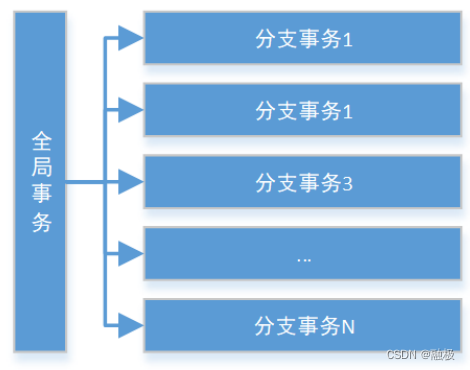
With the traditional 2PC The model of is similar to ,Seata Defined 3 A component to protocol the processing of distributed transactions :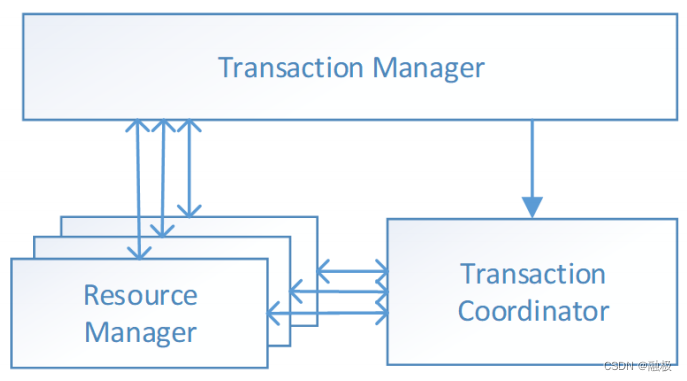
- Transaction Coordinator(TC): Transaction coordinator , It's independent middleware , Need to deploy independently to run , It maintains the running state of global transactions , receive TM Instruction initiate global transaction commit and rollback , Responsible for working with RM Communication coordinates the commit or rollback of individual branch transactions .
- Transaction Manager(TM): Transaction manager ,TM Need to work embedded in the application , It is responsible for opening a global transaction , And finally think TC Instructions to initiate global transaction commit or global rollback .
- Resource Manager(RM): Control branch transactions , Responsible for branch registration 、 Status report , And receive the transaction coordinator TC Instructions , Drive branch ( Local ) Transaction commit and rollback .
Also take the new user registration to send points as an example Seata Distributed transaction process :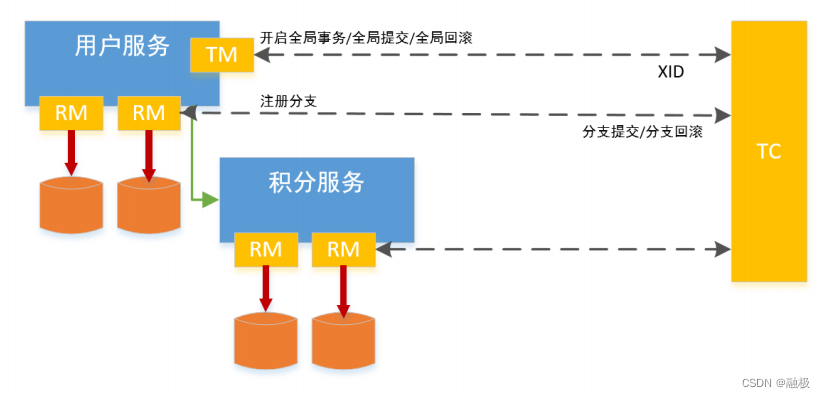
The specific implementation process is as follows
- User service TM towards TC Request to open a global transaction , The global transaction is created successfully and generates a globally unique XID.
- User service RM towards TC Register branch transactions , The branch transaction performs the new user logic in the user service , And include it in XID Jurisdiction corresponding to global transaction .
- The user service performs branch transactions , Insert a record into the user table .
- The logic execution to remote call integral service is (XID Propagate in the context of the microservice call link ). Points service RM towards TC Register branch transactions , This branch transaction performs the logic of increasing integral , And include it in XID Jurisdiction corresponding to global transaction .
- The points service performs branch transactions , Insert a record into the integral record table , After execution , Return to user service .
- User service branch transaction execution completed .
- TM towards TC Launch against XID The global commit or rollback resolution for .
- TC call XID All branch transactions under the jurisdiction complete the commit or rollback request .
Seata Realization 2PC With the traditional 2PC The difference between
Architecture level , Tradition 2PC Of the plan RM It's actually in the database layer ,RM Essentially, it's the database itself , adopt XA Protocol implementation , and Seata Of RM In order to jar The package is deployed on the application side as a middleware layer .
Two phase submission , Tradition 2PC No matter the resolution of the second stage is commit still rollback, The locks of transactional resources should be kept to Phase2 Release when finished . and Seata The way to do this is to Phase1 Commit local transaction , So we can save it Phase2 Time to hold lock , Overall efficiency .
边栏推荐
- 2022, 6G is heating up
- mm_ Cognition of struct structure
- nn. Exploration and experiment of batchnorm2d principle
- Star leap plan | new projects are continuously being recruited! MSR Asia MSR Redmond joint research program invites you to apply!
- R language -- readr package reads and writes data
- Fundamentals of container technology
- When synchronized encounters this thing, there is a big hole, pay attention!
- 22 API design practices
- Recommend a cool geospatial data visualization tool with low code
- Entity framework calls Max on null on records - Entity Framework calling Max on null on records
猜你喜欢

Show recent errors only command /bin/sh failed with exit code 1
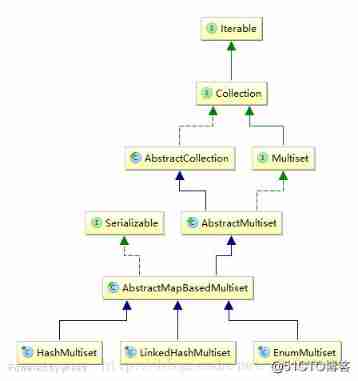
Source code analysis of the implementation mechanism of multisets in guava class library

It's hard to hear C language? Why don't you take a look at this (V) pointer
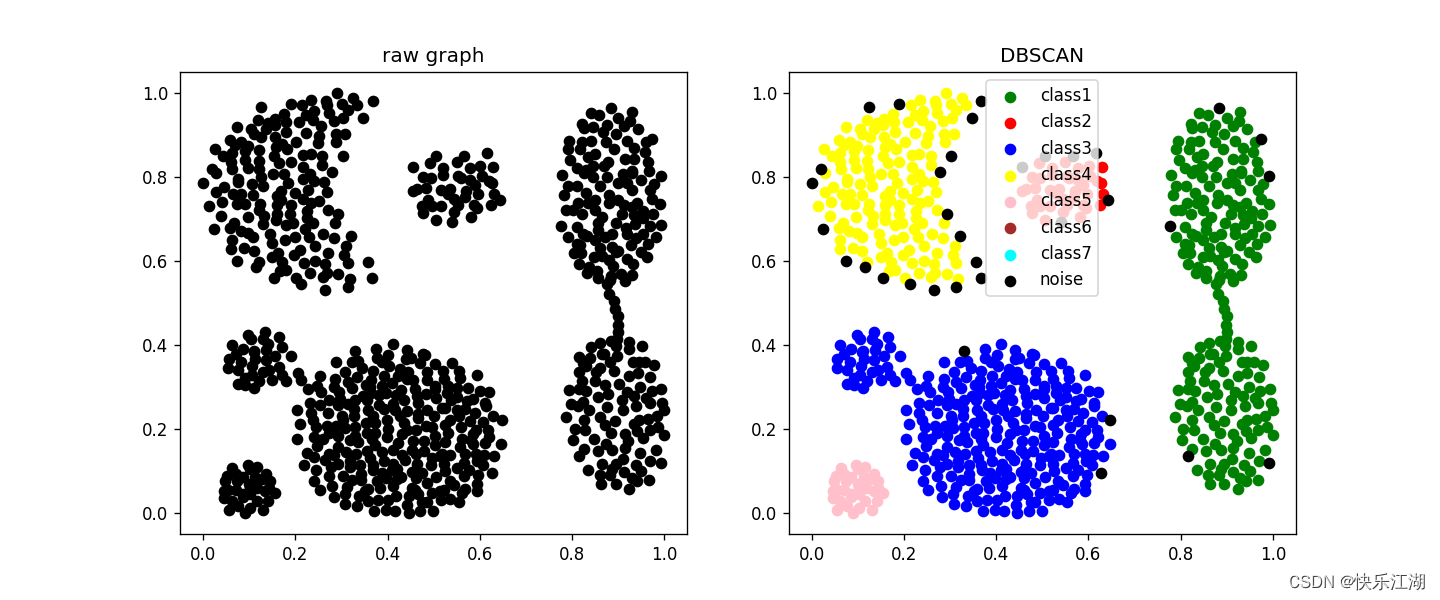
【数据聚类】第四章第一节3:DBSCAN性能分析、优缺点和参数选择方法
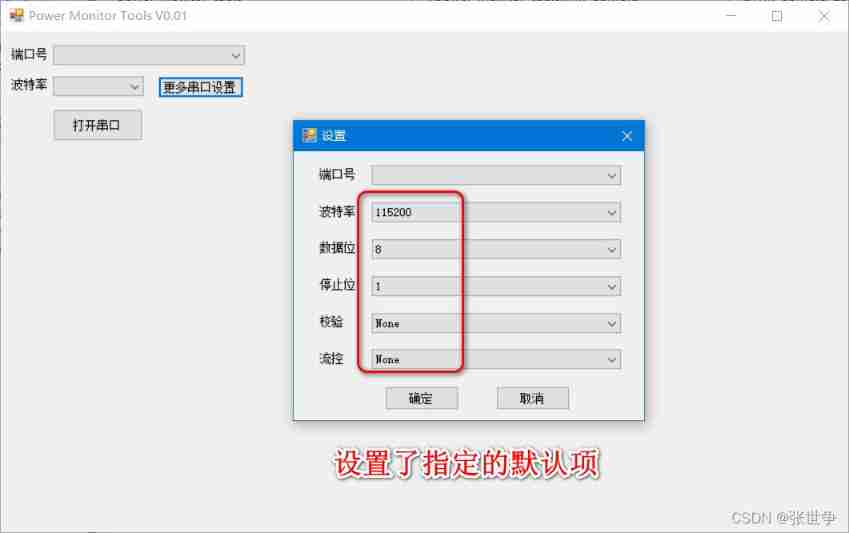
Method of setting default items in C # ComboBox control code
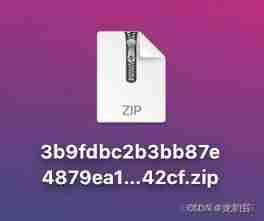
Detailed explanation of NPM installation and caching mechanism
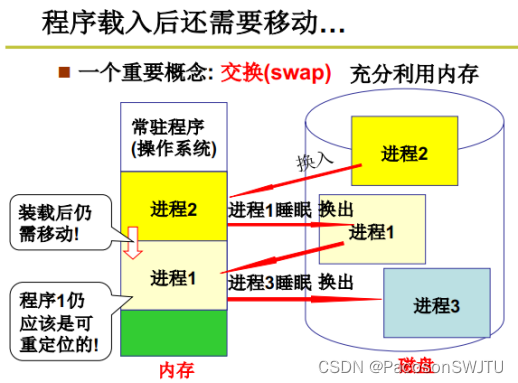
16.内存使用与分段
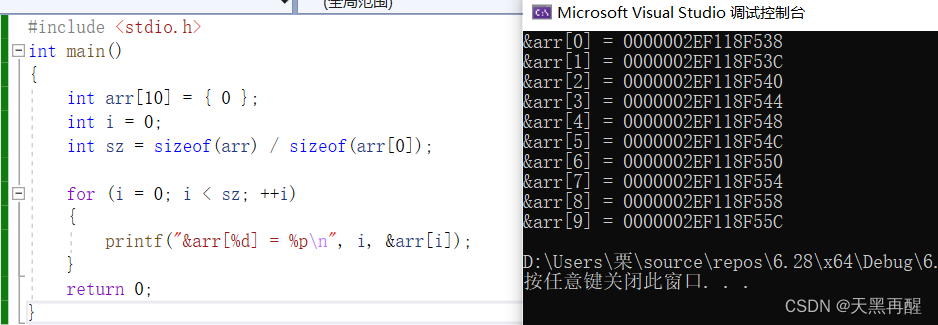
C language array
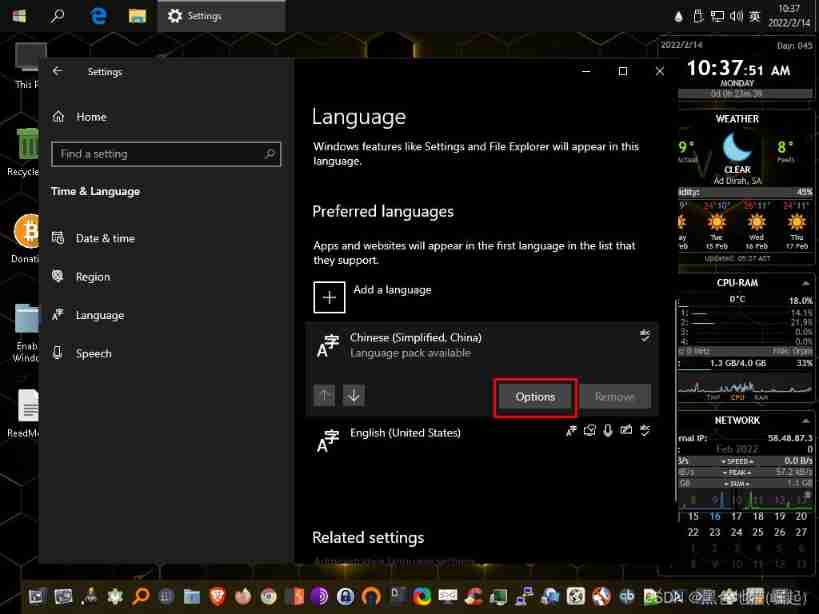
The detailed installation process of Ninja security penetration system (Ninjitsu OS V3). Both old and new VM versions can be installed through personal testing, with download sources
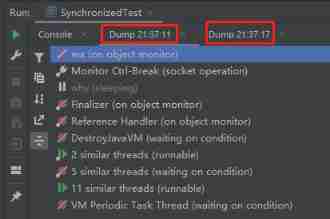
When synchronized encounters this thing, there is a big hole, pay attention!
随机推荐
Hongke case study on storm impact in coastal areas of North Carolina using lidar
vim 出现 Another program may be editing the same file. If this is the case 的解决方法
Interview question MySQL transaction (TCL) isolation (four characteristics)
Lvs+kept highly available cluster
01. Basics - MySQL overview
BCD code Baidu Encyclopedia
Workplace liquor bureau must pay attention to
Global and Chinese markets of NOx analyzers 2022-2028: Research Report on technology, participants, trends, market size and share
Entitas learning [3] multi context system
Servlet learning notes
分布式事务相关概念与理论
IIS error, unable to start debugging on the webserver
PKCs 5: password based cryptography specification version 2.1 Chinese Translation
MySQL performance optimization index
The latest idea activation cracking tutorial, idea permanent activation code, the strongest in history
[notes] in depth explanation of assets, resources and assetbundles
Review of week 278 of leetcode II
Awk getting started to proficient series - awk quick start
MySQL advanced (Advanced) SQL statement
Paper notes ACL 2020 improving event detection via open domain trigger knowledge